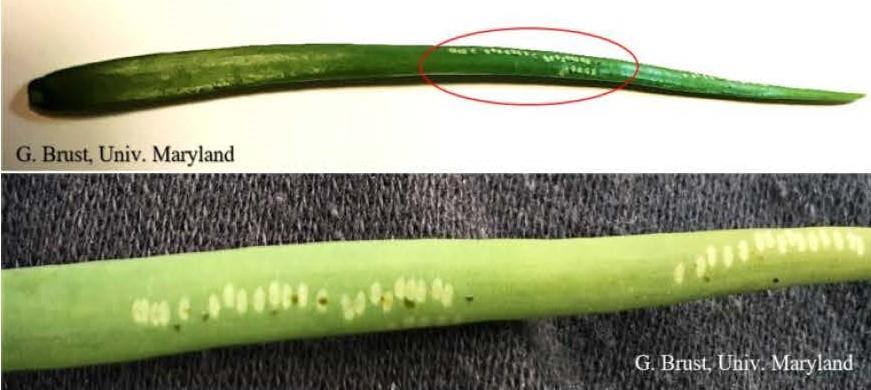
Allium leaf miner Phytomyza gymnostoma is a pest on chives, scallions, garlic, onions, and leeks. Overwinter ALM across the Mid-Atlantic will be emerging soon. Start scouting for ovipositor markings made by female ALM over the next few weeks on food and ornamental Allium crops. These markers will be neat rows of white spots descending from the upper tips of allium leaves. These marks will be typically be seen on the tallest leaves first. ALM Larvae mine leaves and moves towards and into bulbs and leaf sheathes. The leaf punctures and mines serve as entry routes for bacterial and fungal pathogens.
Spring crops are usually not as hard-hit as fall crops, especially when looking at leeks, but this pest has steadily increased its geographical range each year and its damage potential. If you had some infestation last year, you will especially want to look for this pest’s signs.
Yellow sticky cards or yellow plastic bowls containing soapy water can be used for monitoring but are not affected control independently.

Onion leaf blades showing round white dots made by female Allium leaf miners. Photo by Jerry Brust
Cultural Control: Covering plants in February, prior to the emergence of adults, and keeping plants covered during spring emergence, can be used to exclude the pest. Avoiding the adult oviposition period by delaying planting (after mid-May we think) has also been suggested to reduce infestation rates. Covering fall plantings during the 2nd generation flight can be effective. Growing leeks as far as possible from chives has been suggested. Organic
Chemical Control: Azadirachtin (Aza-Direct or other formulations) or spinosad (Entrust or other formulations) follow label instructions for leaf miner.
Synthetic Chemical Control: Systemic and contact insecticides can be effective. EPA registrations vary, however, among Allium crops. Check labels to ensure the crop is listed, and for rates and days-to-harvest intervals. Options that may be effective include cyromazine (Triguard), dinotefuran (Scorpion), spinetoram (Radiant), lambda-cyhalothrin (Warrior II or other formulations), and abamectin (Agri-Mek or other formulations).